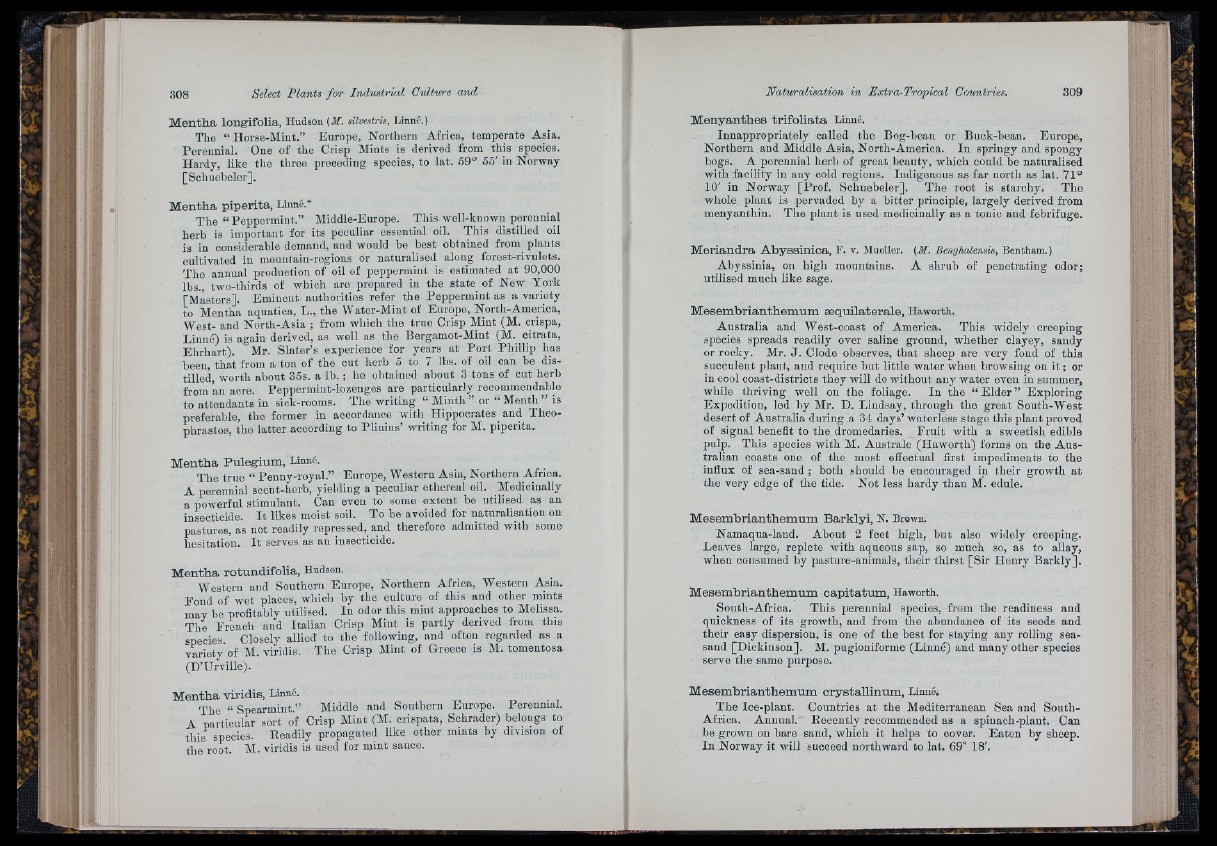
Mentha longifolia, Hudson (M. süvestris, Linné. )
The “ Horse-Mint.” Europe, iSiorthern Africa, temperate Asia.
Perennial. One of the Crisp Mints is derived from this species.
Hardy, like the three preceding species, to lat. 59° 55' in Norway
[Schuebeler].
Mentha piperita, Linné.*
The “ Peppermint.” Middle-Europe. This well-known perennial
herb is important for its peculiar essential oil. This distilled oil
is in considerable demand, and would be best obtained from plants
cultivated in mountain-regions or naturalised along forest-rivulets.
The annual production of oil of peppermint is estimated at 90,000
lbs., two-thirds of which are prepared in the state of New York
[Masters]. Eminent authorities refer the Peppermint as a variety
to Mentha aquatica, L., the Water-Mint of Europe, North-America,
West- and North-Asia ; from which the true Crisp Mint (M. crispa,
Linué) is again derived, as well as the Bergamot-Mint (M._ citrata,
Ehrhart). Mr. Slater’s experience for years at P o rt Phillip has
been, th a t from a ton of the cut herb 5 to 7 lbs. of oil can be distilled,
worth about 35s. a lb. ; be obtained about 3 tons of cut herb
from an acre. Peppermint-lozenges are particularly reeommendable
to attendants in sick-rooms. The writing “ Minth or “ Menth is
preferable, the former in accordance with Hippocrates and Theophrastos,
the latter according to Plinius’ writing for M. piperita.
Mentha P u l e g i u m , Linné.
The true “ Penny-royal.” Europe, Western Asia, Northern Africa.
A perennial scent-herb, yielding a peculiar ethereal oil. Medicinally
a powerful stimulant. Can even to some extent he utilised as an
insecticide. I t likes moist soil. To he avoided for naturalisation on
pastures, as not readily repressed, and therefore admitted with some
hesitation. I t serves as an insecticide.
Mentha rotundifolia, Hndson.
Western and Southern Europe, Northern Africa, Western Asia.
Fond of wet places, which by the culture of this and other mints
may be profitably utilised. In odor this mint approaches to Melissa.
The Prench and Italian Crisp Mint is partly derived from this
species Closely allied to the following, and often regarded as a
vLiety of M. viridis. The Crisp Mint of Greece is M. tomentosa
(D’Urville).
Mentha viridis, Linné.
The “ Spearmint.” Middle and Southern Europe. Perennial.
A particular sort of Crisp Mint (M. crispata, Schrader) belongs to
this species. Readily propagated like other mints by division of
the root. M. viridis is used for mint sauce.
Menyanthes trifoliata Linné.
Innappropriately called the Bog-bean or Buck-hean. Europe,
Northern and Middle Asia, North-America. In springy and spongy
bogs. A perennial herb of great beauty, which could be naturalised
with facility in any cold regions. Indigenous as far north as lat. 71°
10' in Norway [Prof. Schuebeler]. The root is starchy. The
whole plant is pervaded by a bitter principle, largely derived from
menyanthin. The plant is used medicinally as a tonic and febrifuge.
Meriandra Abyssinica, F. V. Mueller. {M. Benghalensis, Bentham.)
Abyssinia, on high mountains. A shrub of penetrating odor;
utilised much like sage.
Mesembrianthemum æquilaterale, Haworth.
Australia and West-coast of America. This widely creeping
species spreads readily over saline ground, whether clayey, sandy
or rocky. Mr. J . Clode observes, that sheep are very fond of this
succulent plant, and require bnt little water when browsing on it ; or
in cool coast-districts they will do w ithout any water even iu summer,
while thriving well ou the foliage. In the “ Elder ” Exploring
Expedition, led by Mr. D. Lindsay, through the great South-West
desert of Australia during a 34 days’ waterless stage this plant proved
of signal benefit to the dromedaries. F ru it with a sweetish edible
pulp. This species with M. Australe (Haworth) forms on the Australian
coasts one of the most effectual first impediments to the
influx of sea-sand ; both should be encouraged in their growth a t
the very edge of the tide. Not less hardy than M. edule.
Mesembrianthemum Barklyi, N. Brown.
Namaqua-land. About 2 feet high, but also widely creeping.
Leaves large, replete with aqueous sap, so much so, as to allay,
when consumed by pasture-animals, their th irst [Sir Henry Barkly].
Mesembrianthemum capitatum, Haworth.
South-Africa. This perennial species, from the readiness and
quickness of its growth, and from the abundance of its seeds and
their easy dispersion, is one of the best for staying any rolling sea-
sand [Dickinson]. M. pugioniforme (Linné) and many other species
serve the same purpose.
Mesembrianthemum orystallinum, Linné.
The Ice-plant. Countries a t the Mediterranean Sea and South-
Africa. Annual. Recently recommended as a spinach-plant. Can
be grown on bare sand, which it helps to cover. Eaten by sheep.
In Norway it will succeed northward to lat. 69° 18'.
I' •